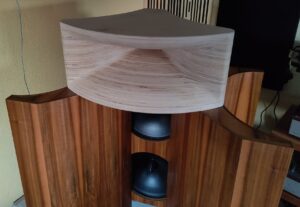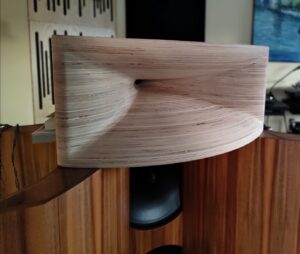In this article I would like to share some measurement results for my new WN300ALO plywood horn. Based on the PLA prototype described here
https://sphericalhorns.net/2022/09/20/acoustic-loading-optimized-william-neile-horns-part-2/
some initial measurements were already done and a preliminary passive crossover network was designed for use in my existing speaker system. This way it was possible to immediately have a listening session when the horns arrived at my home. The measurement results for the PLA horn have not been published because of my concerns about using PLA for such a large horn mainly because of inherent self resonances. And indeed some pronounced and distinct resonances were present in all the measurement data. This has been also verified by spectral analysis when knocking on the horn at different regions. But the results were still good enough for designing a crossover network knowing the problematic resonance frequencies. Maybe it is possible to change the the outer shape of the PLA horn providing better damping. In total contrast to the PLA version the full block plywood version has exceptional good internal damping properties which was one of the main reasons to choose this material and the overall shape of the horn.
Basically it was planned to have a reference setup to compare to so we first listened to the my existing speaker system with 18sound ND3SN@TH4001 fin horn which was my primary choice since a longer time. The TH4001 was a big improvement compared to round Tractrix or any CD horn I tested in my system except for some missing depth of the 3D soundstage. After some songs with the TH4001 in place we mounted the WN300ALO and also changed the readily prepared HF part for the crossover network. What happened with the sound reproduction by switching to the new WN300ALO horn surpassed my highest expectations.


